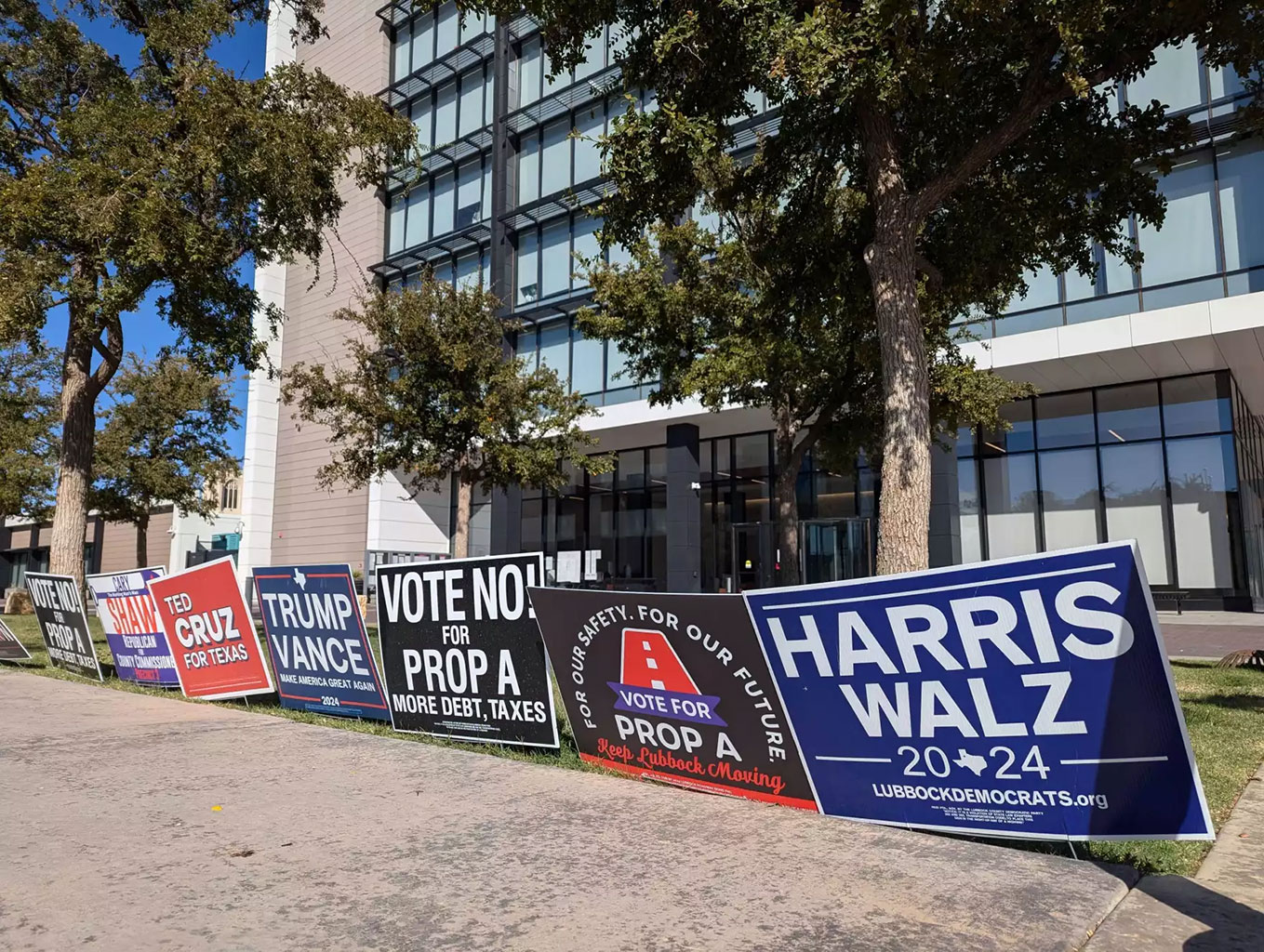With more than 85,000 votes in Lubbock County, more voters chose former president Donald Trump to be the 47th President of the United States than voted in his favor in 2020 by a margin of more than 7,000 votes; and nearly 10,000 votes over what he received from Lubbock County in 2016.
Trump, who became the first President to be convicted of a felony in May 2024 with guilty verdicts on 34 charges of falsifying business records to cover up hush money payments to a porn star, will return to the White House in January. His challenger, sitting Vice President Kamala Harris, called Trump Wednesday to concede the election with 224 electoral college votes, compared to Trump’s 292.
Harris received just under 30% of the vote from Lubbock County, less than 4,000 votes below what current President Joe Biden received in 2020.
U.S. Senator for Texas Ted Cruz saw an even bigger increase in the number of Lubbock County voters in his favor than his last run versus former congressman Beto O’Rourke in 2018; but as a percentage of registered voters, the turnout in support of Cruz looked similar. Cruz’s challenger for 2024, Congressman Colin Allred, saw a 5% decrease in support from Lubbock County than O’Rourke.
U.S. Representative for District 19, Jodey Arrington, carried 75% of the Lubbock County vote against Libertarian candidate Bernard Johnson and independent Nathan Lewis.
For Texas State Board of Education, Lubbock Democrat Morgan Kirkpatrick carried an active campaign against Midland Republican and incumbent State Board of Education chair Aaron Kinsey, but Kinsey came away from Lubbock County with 67.5% of voters in his favor.
In the Texas House of Representatives, District 84 congressman Carl Tepper defeated Lubbock-based Democrat Noah Lopez with 64% of the vote, a split that follows historical races for that seat. District 83 Republican Dustin Burrows will take another term after running unopposed.
The most surprising upset was in the race for Lubbock County Commissioner, Pct. 3, where Republican Cary Shaw narrowly beat incumbent Democrat Gilbert Flores with a lead of 910 voters, or 5% of the vote. That precinct covers mostly eastern portions of Lubbock and has been consistently held by a Democrat for almost 30 years.
Record-breaking turnout for voters in and around Lubbock was still not able to meet expectations by the Elections Office, with a total percentage just over 62% of registered voters in Lubbock County.
Judge Curtis Parrish said after the announcement of final unofficial results in the county, there were no hiccups in the process this year and he’s pleased with the turnout numbers.
“Over 110,000 people voted in Lubbock County over the last two weeks. And that is a phenomenal amount of folks to come out and vote,” Parrish said. “In fact, it’s our highest voter turnout that we’ve had in Lubbock County history.”
On the southwestern side of the city, voters in the Highland Oaks neighborhood approved a proposal to accept annexation into Lubbock city limits. The proposal came as some residents felt that their well water resources were struggling, and it was time to join the city’s public works. This drew some controversy among residents, who said they moved to the neighborhood to be separate from the city of Lubbock.
Now that the city’s southern edge has reached the neighborhood, residents voted firmly to approve annexation, with nearly 70% of votes in favor of joining the city of Lubbock.
The City of Lubbock’s $103 million street bond to build new road projects and repave almost a mile of downtown Broadway’s historic bricks passed with a difference of more than 5,000 voters approving. The projects will construct or renovate paved streets in southern and western parts of the city, with the only exception being the most expensive item on the bond: repaving aging historic bricks on Broadway from Avenue Q to Avenue E, with “concrete and modern brick pavers.”
The Broadway project is expected to cost $16 million of the bond. The proposition was rejected in north, east, and central Lubbock precincts by some who felt the bond placed an added cost to build out southwest Lubbock, which many in the older parts of the city feel they will have to pay for.
The bond brings a new five-year cost as Lubbock voters can still see the last street bond in progress. More than half of the 16 projects from 2022’s $200 million street bond are awaiting construction in the next three years.
Meanwhile, street growth saw significant financial support. The Political Action Committee supporting this year’s bond reported $85,000 in total contributions on the 8th-day campaign finance report, $6,000 more than the PAC that promoted 2022’s bond.
Robert Arcos, 24, is a first-time voter in this election. Arcos said he was worried about the future with aspects of this year’s election, and this year he decided to say something.
Arcos lives near the Reese Center. He said that when it comes to the street bond, he understands the concerns regarding equity and representation, but he said the work needs to get done to support Lubbock’s growth.
“There’s houses being built continuously. With them doing that, it’s making the area look at least a little nicer. But I do agree that more areas do need to be focused on too,” Arcos said. “That’s gonna have to go one step at a time.”
Frankie Garcia works in the oil industry here in Texas, and he came out to Frenship Heritage Middle School to cast his vote. He says he came out to support former president Donald Trump. Garcia said that in addition to the presidential race, he voted on local issues like Lubbock’s Prop A street bond. He pointed down the street to where he feels road maintenance is still needed.
“Take the turn right here, and you’ll see a couple of improvements that need to get made, like immediately,” Garcia said.
Frenship Independent School District’s three propositions followed similar lines in favor.
According to Frenship ISD, Proposition A will generate more than $9 million in additional local revenue and state aid for Frenship’s Maintenance and Operations (M&O) budget each year, allowing Frenship to increase staff salaries by an average 3% this school year, on top of the average 2% increase staff received earlier this year.
Proposition B will fund the construction of two new elementary schools and renovate old campuses to accommodate the increase in student enrollment, while Proposition C is a technology bond to purchase additional technology and replace older devices for students and staff.
Frenship ISD noted that demographers predict Frenship’s student enrollment will surpass 15,000 students by 2030.
Even though voters approved an increase to the M&O tax rate, according to Frenship ISD, the overall tax rate is Frenship’s lowest tax rate in 30 years and will still allow Frenship to carry out the projects approved by voters in Propositions B and C, totaling $199.5 million in bonds.
“We want to say thank you. Thank you to our parents, students, staff, and community who voted. We are so grateful to have such a supportive community that recognizes the needs that come with being one of the fastest-growing school districts in Texas,” Frenship ISD Superintendent Dr. Michelle McCord said in Wednesday’s release.
53-year-old Deborah Vasquez is a regular voter, both for national races and local elections.
“I am concerned about the future for my kids,” Vasquez said. “And I want them to be able to have the American dream, a home, a family, and I can’t miss that.”
She says that all four of her children went through Frenship Independent School District, but when it comes to the voter-approved tax ratification election (VATRE) and bond election, there are a lot of elements to take into consideration.
“There is a lot of growth out there, and so I’m glad to see that, but these are different times, so we’ve got to really weigh in where we’re at and what we need to do,” Vasquez said.
On the street bond, Vasquez said she voted with the information she had on election day, but the future is still unknown.
“I don’t see a problem with that, as far as I can tell,” Vasquez said. “Now, if you ask me sometime next year, I’d probably be against it. It just depends how this year goes.”
Judge Parrish said the support for these efforts with the increased turnout confirms that Lubbock County is growing, and he believes citizens want to support that. Parrish referred to a conversation with a Texas demographer who expects Lubbock County to see 500,000 people by the year 2040.
“We are growing and growing rapidly,” Parrish said. “And we’ve got to make sure that the infrastructure of the county meets that growth.”
24-year-old Shylynne Kreisher is from Pennsylvania, she moved to Lubbock about five years ago and took this election to become more informed on the local issues.
“The last election, I didn’t vote. I wasn’t too informed on anything. And this year, I was like, no,” Kreisher said. “I came out recently, so I was like, no, I should really help me and my fellow members of the LGBTQ+ [community].”
Kreisher was motivated by the desire to support fighting for the rights of women and the queer community and was compelled by Lubbock’s local ballot items as well.
“I definitely want to help our school, help our teachers. Hopefully it goes through and our teachers can get the respect and stuff they deserve because they go through a lot,” Kreisher said. “I don’t want to just turn a blind eye and be like, ‘oh, too bad. So sad.’”
Even before the final results were read, Kreisher said she felt better having cast her own ballot. “No matter how things go, I got to put my voice in my votes there.”



